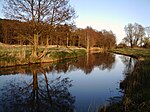Eldena Abbey
1190s establishments in the Holy Roman Empire1199 establishments in Europe1535 disestablishments in the Holy Roman EmpireBurial sites of the House of PomeraniaChristian monasteries established in the 12th century ... and 6 more
Church ruins in GermanyCistercian monasteries in GermanyMonasteries dissolved under the Protestant ReformationMonasteries in Mecklenburg-Western PomeraniaReligious organizations established in the 1190sRuined abbeys and monasteries

Eldena Abbey (German: Kloster Eldena), originally Hilda Abbey (German: Kloster Hilda) is a former Cistercian monastery near the present town of Greifswald in Mecklenburg-Vorpommern, Germany. Only ruins survive, which are well known as a frequent subject of Caspar David Friedrich's paintings, including the famous Abtei im Eichwald ("Abbey in the Oak Forest").
Excerpt from the Wikipedia article Eldena Abbey (License: CC BY-SA 3.0, Authors, Images).Eldena Abbey
An der Klosterruine,
Geographical coordinates (GPS) Address Nearby Places Show on map
Geographical coordinates (GPS)
| Latitude | Longitude |
|---|---|
| N 54.0892 ° | E 13.45222 ° |
Address
An der Klosterruine
17493 , Eldena
Mecklenburg-Vorpommern, Germany
Open on Google Maps







